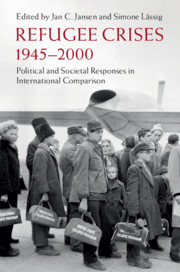Book contents
- Refugee Crises, 1945–2000
- Publications of the German Historical Institute
- Refugee Crises, 1945–2000
- Copyright page
- Contents
- Contributors
- Acknowledgments
- 1 Responses to Refugee Crises in International Comparison
- Part I The Postwar and Decolonization Moment
- Part II Refugee Movements during the Cold War and beyond
- 7 The 1956–1957 Hungarian Refugee Crisis and the Role of the Canadian Press in Opening the Doors to Asylum Seekers
- 8 Responding to and Resettling the Vietnamese Boat People
- 9 US State and Civil Society Responses to Salvadoran Refugees, 1980–1991
- 10 The Plight of the First Post–Cold War Refugees
- 11 Rwandan Refugees in Tanzania, 1994–1996
- Part III Afterword
- Index
10 - The Plight of the First Post–Cold War Refugees
The Reception and Settlement of Bosnians in Austria and the United States
from Part II - Refugee Movements during the Cold War and beyond
Published online by Cambridge University Press: 13 October 2023
- Refugee Crises, 1945–2000
- Publications of the German Historical Institute
- Refugee Crises, 1945–2000
- Copyright page
- Contents
- Contributors
- Acknowledgments
- 1 Responses to Refugee Crises in International Comparison
- Part I The Postwar and Decolonization Moment
- Part II Refugee Movements during the Cold War and beyond
- 7 The 1956–1957 Hungarian Refugee Crisis and the Role of the Canadian Press in Opening the Doors to Asylum Seekers
- 8 Responding to and Resettling the Vietnamese Boat People
- 9 US State and Civil Society Responses to Salvadoran Refugees, 1980–1991
- 10 The Plight of the First Post–Cold War Refugees
- 11 Rwandan Refugees in Tanzania, 1994–1996
- Part III Afterword
- Index
Summary
From 1992 to 1995, more than 2.2 million Bosnians were expelled from their homes in the former Yugoslavia. As they fled from the ethnonational violence that had overtaken their country, they encountered policies of containment and exclusion in many host countries. The Austrian Parliament and the US Congress passed legislation restricting the granting of refugee status and refugee benefits. The residence law Austria adopted in 1992 and enactedin 1993 eliminated the option for Bosnians to obtain refugee status on the basis of the 1951 Convention on Refugees. Bosnians entering the United States after the enactment of the 1996 Illegal Immigration Reform and Immigration Responsibility Act found a newly implemented multistep screening process. This essay reviews the two governments’ policies toward refugees in general and toward the Bosnian newcomers in particular. It examines the integration dilemmas and pitfalls that the Bosnians faced. Despite the shift from protection to exclusion in refugee policy that occurred in many liberal democracies, and despite the clear circumvention of responsibility for Bosnian refugees by the Austrian state, the vast majority of Bosnians in Austria and the United States managed to remain and were integrated into the host societies.
- Type
- Chapter
- Information
- Refugee Crises, 1945-2000Political and Societal Responses in International Comparison, pp. 235 - 259Publisher: Cambridge University PressPrint publication year: 2020



